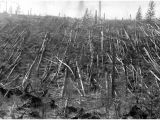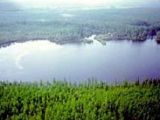The biggest space impact suffered by Earth in modern times is the Tunguska event, when an impact put down more than 2,000 sq km of forest near the Tunguska River (Siberia) on 30 June 1908. It could have been a comet or asteroid blasting in the atmosphere with a power similar to 1,000 Hiroshima bombs explosions (20 millions tones of TNT).
Now, a University of Bologna team claims that a lake - located 8 km (5 mi) north-north-west of the epicenter of the event - could fill the crater dug by a rock chunk coming from the space body hitting the ground. "Lake Cheko - though shallow - fits the proportions of a small, bowl-shaped impact crater," said the Italian team.
The lake bottom's relief has a funnel-like shape not encountered in neighboring lakes, and under 10m, the lake bed shows a disconnection that could be either compacted lake sediments or a fragment of space rock. "We have no positive proof this is an impact crater, but we were able to exclude some other hypotheses, and this led us to our conclusion," lead researcher Professor Giuseppe Longo, told BBC News.
The Tunguska body is believed to have exploded some 5-10km above the ground, so brightly and powerfully that it was seen on the London sky. Small rock fragments could have survived the blast and reached the Earth, but the mystery of the event is that no crater and not even the smallest trace of the impact have been discovered till now. "In my opinion, they certainly haven't provided any conclusive evidence it's an impact structure," said Dr Gareth Collins, a research associate at Imperial College London, UK.
"The impact cratering community does not accept structures as craters unless there is evidence of high temperatures and high pressures. That requires evidence of rocks that have been melted or rocks that have been ground up by the impact."
"The Cheko feature was "anomalously" shallow and lacked the round shape of most craters - being more elliptical in its form. Elliptical craters only occur if the impactor's angle of entry is less than about 10 degrees. We know from modelling of the Tunguska event that the angle of entry must have been steeper than that," Collins told BBC News.
There is another trait of the impact craters lacking from Lake Cheko - a "flap" surrounding the crater rim made of upside-down material thrown at short distance by the hit. "If pieces of the space rock had survived the airburst, they would have been too small and traveling too slowly to have generated a crater the size of Lake Cheko. An impact would also have felled trees all around the crater, yet there appeared to be trees older than 100 years still standing around Lake Cheko today", said Collins.
Computer models showed that centimeter-sized rocks could have been tossed hundreds of kilometers away from Tunguska.
The Italian researchers say that the uncommon structure could be explained by a slower speed of the cosmic rock and attenuated impact on the swampy Siberian taiga, and the crater would have been enlarged by the water and gas expelling from the ground.
"This could also account for the limited damage to the surrounding area and the absence of a rim of upturned ejecta. If formed during the impact, [the rim] would have been rapidly obliterated by collapse and gravity-failures during the subsequent degassing phase," the authors wrote.
Lake Cheko was not mapped before 1929, but the area was poorly charted at that time. The Italian researchers will make another expedition in summer 2008 to the Tunguska region, with the intention of getting drilled probes up to 10m below the lake bed to the anomaly picked up in the geophysics investigation, to see the nature of that rock.
Who knows, it may be cosmic...

 14 DAY TRIAL //
14 DAY TRIAL // 

